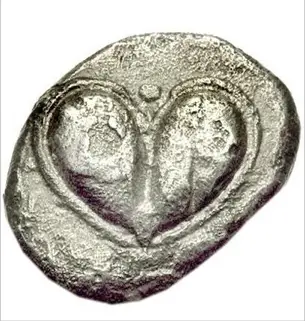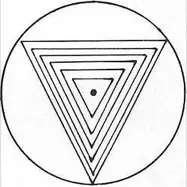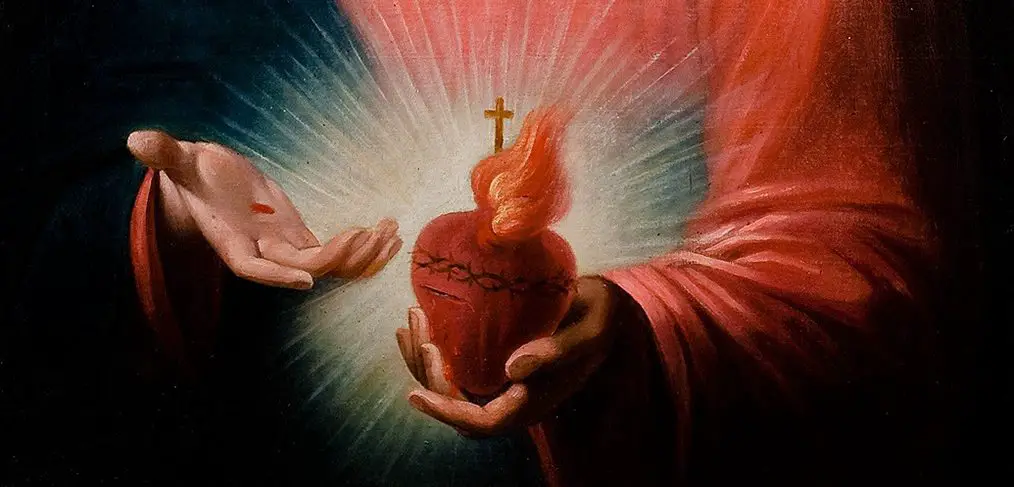This article aims to investigate the analogies between some of the preeminent symbolic and esoteric values of the heart and the female genital organ. In the different traditions of human history and, not infrequently, even in mere common language, the two organs, in fact, have often been associated with the same symbolic representations, such as those of the triangle with the apex down, the vase and the cave. Representative communities, these, which cannot but intuitively refer to a common area of meanings.
di Luke of James
cover: illuminated manuscript, France, XNUMXth century
This article aims to investigate the analogies between some of the preeminent symbolic and esoteric values of the heart and the female genital organ. In the different traditions of human history and, not infrequently, even in mere common language, the two organs, in fact, have often been associated with the same symbolic representations, such as those of the triangle with the vertex down, the jar and cave. Representative commonalities, these, which cannot but intuitively refer to a common area of meanings.
The present reflections originate precisely from the possibility of inscribing the normal symbol of the heart in an inverted triangle, that is, that glyph with two humps in the upper part that narrows downwards until it ends with a tip. Immediate appears to be the juxtaposition with the triangle of yoni, which, in the Hindu tradition, symbolizes the different levels of femininity, referring materially to the vulva, allegorically to fertility, metaphysically to the concept of "substance / power", personified by the goddess Shakti. Complementary to the yoni is the phallic lingam of Shiva, emblem of virility, of fecundating power and of the essential principle of the universe. The consonance of the triangle with the vertex facing downwards with the female sphere is also consolidated in the West, where this geometric figure is the emblem ofWater element and of its precipitating motion, feminine counterpart, in the elementary quaternary, of the male element Fire and related to the same concepts of femininity, power and substantial matrix mentioned above.

On the other hand, there could be some friction in the juxtaposition between the inverted triangle and the the heart, traditionally the seat of spiritual principles and intuitive faculties which are best suited to symbols of a fiery / solar character. The contrast, however, turns out to be only apparent, not only because the inverted triangle is the spontaneous glyph of every recipient object (see below), but also in the light of the hermetic tradition contemplating the glyph of the inverted triangle surmounted by the cross [1]. As observed [2], the different position of the cross, in the hermetic symbolism, indicates the progress of the work relative to the material symbolized by a basic geometric figure: if the cross is at the base of the figure, the work is still to be done, if, instead, the overlap, the processing of the material is complete. For a sort of symbolic enantiodromy, therefore, the sulfur glyph (triangle that surmounts a cross), the fiery symbol of the spiritual component of the human compound, has its reverse side in the cross that surmounts the triangle with apex downwards, emblem of the Great Work completed, symbol of the successful distillation (cross at the top) of all waters (inverted triangle at the base) [3], that is of the soul / mercurial element of man. This procedure corresponds exactly to the purification of the heart as the center of individuality [4].
Having ascertained the harmonious coherence of the aforementioned symbology, we can proceed further, examining the ability of the vulva and the heart to fill up with the precious liquid of the blood. The first is filled with it monthly, in a cyclical bath of renewal of fertility; the cardiac organ is constantly filled with them, in un continuous and rhythmic flow perpetuating life. The two organs, therefore, are symbolized by recipient objects. Commonly, in fact, the passive-recipient capacity and the desire of the male to "drink" from it in common sexual practices have often brought the vulva closer to the cup. Even in the esoteric field, the seed of "Cups" of the Cards is compared to the female genital organ, while the seed of "Batons" to the phallus, the seed of "Spade" to sexual penetration, the seed of "Danari" to childbearing fertilization [5]. Obviously, these are symbols capable of being analogically translated onto higher levels than the sexual one.

Equally, it is well known that the Egyptian hieroglyph of the heart (ib) consisted of a jar and that this correspondence is one of the most illuminating interpretative keys to understand the symbology of Holy Grail [6], the relic that was originally emerald between the eyes of Lucifer, then a chalice carved by the Angels to give it to Adam and reconquered by Seth after the "fall" of the progenitor of humanity, which became a wine cup during the meeting between Abraham and Melchisedeq , priest of eternal spirituality, then chalice of the Eucharistic Wine / Blood at the Last Supper and providential instrument used by Joseph of Arimathea to collect the blood of Christ crucified.
Penetrating the complex symbology just exposed, albeit briefly, it can be said that the legendary relic refers to a superhuman state of the intellect (the emerald of Lucifer) also belonging to the primordial nature of man (both Adam and Seth received him inEden), as well as highly spiritual knowledge (Melchisedeq) [7] and the secret of immortality (wine, drink of immortality, and the blood of Christ / Logos who dies and rises again). Bearing in mind the original identification of the heart with the vessel, it is therefore believed that the Grail, sub species interioritatis, it is a symbol, in the Christian tradition, of the heart itself, physically vessel or cup of blood, muscle of life, which must be initiatedly transmuted into a receptacle of Wisdom and abode of Immortality by the man who made his intellectual faculties descend into the heart [8] (the frontal emerald that becomes the chalice) and has reached the center of his own Being, an interior and subtle place accorded to the Logos creator of all things.

Another symbol held in common by Heart and Vulva is that of Cave [9]. The hollow shape of the heart muscle amply justifies the juxtaposition with the cave, confirmed by the recurrence of traditional expressions such as "Heart cave". This symbology is linked to the notion of "Center": the cave is symbolically a "center" in the macrocosm of the Universe, just as the heart is the vital, subtle, sapiential center of man. Also the cave, in turn, is usually represented by the inverted triangle, opposite to the triangle with the vertex upward depicting the mountain (in which it is usually inscribed), another symbol of the Center which, however, seems to have an external, opposite and complementary to "internal", "hidden", "cryptic" nature of the cave.
This occult centrality has meant that the cave was a recurring emblem and even a physical place of initiatory rites, since only the Center, the median place, is suitable for putting the human world in communication with the influences of the lower and upper planes that propitiate rebirth. . However, the hollow, humid, chthonic-telluric nature, closely connected to the Earth element and the powers of fecundity, inevitably contributed to affirming the correspondence between the cave and the vaginal cavity, the material epicenter of fecundity and generative capacity, therefore ideal type of every place where man is called to be reborn. The entrance into the caves is, therefore, a symbolic act of a regenerative return, through the passage in the vulva / entrance, to the uterus of the Great Mother Earth. [10] (regressus ad uterum), an opportunity for a reconnection to the original germ of one's own and universal existence.

Further points for reflection in the sense outlined above, albeit on a more relative level, can be derived from occult conceptions of sexuality [11], which identify two different subtle, magnetic, fluidic centers in the human body, oppositely polarized according to the individual sex. The first center, located in the genital area, is obviously actively polarized in the man, passively in the woman, reflecting the role of the phallus and vulva in penetration. The other center is located in the upper body area. According to some, it must be identified in the head, but it is believed that this is a superficial idea or, in any case, pertaining to partial or "fallen" conceptions, aimed at locating the center of human individuality in the region of the rational faculties, rather than in the heart area , as the seat of profound individuality and of the higher intuitive faculties. The heart center is polarized in an inverse way with respect to the sexual one, characterizing itself actively in the woman and passively in the man [12].
The sexual encounter is, therefore, an opportunity for the encounter between two poles of lovers, when, on the occasion of genital penetration, the woman can penetrate subtly into the heart center of the man, creating a fluidic circuit - "two-vessel" alchemical operation - between the four poles located between the two bodies, which determines the fullness of sexual intercourse. When the conditions for this fluidic penetration are met, by living the act with a ritual and anagogic attitude, one can take advantage of the transmuting possibilities of sex. [13]: the opening of the "cardiac vulva" in man will then equate to the solution and the reconciliation of rational (Saturn), egoic (Jupiter), angry / oppositional (Mars) excesses, while the development of a penetrative cardiac capacity by the woman, will be able to allow her to coagulate her personality above the irrational drifts (Moon), volatile on the psychic plane (Mercury) and concupiscient (Venus) of her own nature [14]. In any case, beyond the differentiation just made, the heart of everyone, whether male or female, always lends itself, in the sexual sphere, to being penetrated by electrocution of Eros, capable of dissolving, even if only in a fleeting mental way if not in a higher sense, the knot of personal individuality [15].

Having reached this point of the investigation, it is believed to be able to definitively meditate on the symbolic continuity between the Heart and Vulva. In the opinion of the writer, what led to the co-ownership of symbols between the two organs is their common generating function: the vulva presides over bodily birth as the heart presides over the palingenesis of the individual. In both cases, the respective cavities lend themselves to the reception of the masculine element, sperm in sexual intercourse and fiery-solar spirit, which must descend or ignite in the heart, in spiritual rebirth, since it is in these two cups that it has elected its seat, on different levels such as the biological and the hieroglyphic, the contiunctio oppositorum between active and passive, full and empty, masculine and feminine, spermatic white and menstrual red [16], "To perform the miracle of the only one" [17], that is, of the third who by overcoming the opposites, both sexual and allegorical, transcends them, sublimates them, harmonizes them: biological son in one case, reborn man in the other. And indeed, understood in this way, the Vulva and the Heart are similar as extreme opposites of individualized and bodily existence, which for all begins with the crossing of the sweet female cavity and will be transcended by a few, through "the opening of the heart" , taking off into the Universal.

Note:
- Also traced by some mystical representations of the Heart of Christ (see above).
- O. WIRTH, The Tarot, Ed. Mediterranee, 2014, p. 65.
- Ivi, p. 70.
- Note from J. EVOLA to LEO, The experience of the subtle body in Introduction to Magic, vol. THE, Ed. Mediterranee, 2004, p. 74.
- G. KREMMERZ, Corpus totius philosophorum Magiae, Second Book, The Sophia, P. 63.
- R. GUÉNON, The Sacred Heart and the legend of the Holy Grail e The Holy Grail in Symbols of Sacred Science, Adelphi, 1975, pp. 6 and following
- It is curious to see how even the Celtic Iapetus Grail was initially preserved in a Primordial Center, exactly Hyperborean, and then it was taken from there by a divine lineage, like that of Seth, the Tuatha, and delivered to the Druid priests.
- On the value of the heart in Hesychast ascesis, with interesting comparisons with Christian mysticism and Sufism, cf. E. MONTANARI, Fatigue of the heart, Java Bookl, 2003.
- R. GUÉNON, The Heart and the Cave in Symbols, cit., pp. 62 ff. The author points out that the Indian term "Guha" can refer both to the cave and to the heart cavity where the unconditioned Atma resides.
- Some elements taken from the Islamic esoteric tradition “providentially” corroborate the symbolic continuity between the Cave, the Heart and the Primordial Feminine Element. The perfection of being is represented by the degree of "Universal Man" (Insanu Al Khamil), symbolic union between primordial man and woman, Adam and Hawa. Adding the numerical value of the letters that form “Adam wa (conjunction) Hawa” we have 66, number of Allah. Emblem of the perfect interpenetration between the masculine and the feminine is the conjunction of the triangle and its reverse in the Seal of Solomon. As suggested, however, the symbolism is subject to an interesting extension if the inverted triangle is inscribed in the triangle with the vertex up, so as to have a large triangle formed by four different equal triangles, one of which is inverted. The latter, also a symbol of the heart and the cave with reference to the straight triangle of the Mountain, is connoted in a feminine sense not only for the assumed direction but also on the basis of the precise numerical and geometric correspondence for which the inverted triangle is equal to ¼ of the triangle integer, like the numerical value of the word Hawa, equal to 15, is equal to ¼ of the total numerical value of Adam plus Hawa without the conjunction "wa", ie 60. Cf. M. VALSAN, Sufism and Hesychasm, Ed. Mediterranee, 2000, p. 30.
- See G. MACIOCIA, Fundamentals of Chinese Medicine, Edra, 2017; PB RANDOLPH, Magic sexualis, Ed. Mediterranee, 2020.
- “[…] The chest, the solar symbol par excellence, takes on different connotations according to sex; noble and glorious radiance in both cases, but demonstrating power in the first case, generosity in the second ", F. SCHUON, From the Divine to the Human, Ed. Mediterranee, 1993, p. 97.
- In this regard, above all, J. EVOLA, Metaphysics of sex, Ed. Mediterranee, 2006.
- The reflection that is noted refers to the sexes in an obviously archetypal sense.
- “Nothing is duller than the heart struck by an arrow (the arrow, of which the Ancients together with the torch, made an attribute of Eros personified): it is a favorite theme even in the tattoos of sailors and criminals. But at the same time it is like a hieroglyph that […] reveals a singular intensity of meaning. In its most typical forms, eros manifests itself as a kind of trauma in the central point of the individual being, which esoterically is the heart. According to mutually agreed traditions, the bond of the individual Ego is essentially established in the heart, to be broken if one wishes to participate in a higher freedom. " J. EVOLA, Metaphysics, cit., p. 104.
- Colors of the two columns of the Masonic Temple, Boaz and Jachin. The names of the two columns, on the contrary, appear to be, considering only the consonates, ZB and NK, which in Hebrew mean respectively "phallus" / "fertilizing organ" and "coitus / copula", cf. J. BOUCHER, Masonic symbolic, Atanor, 2015, p. 186.
- Quote taken from the Emerald Table of Hermes Trismegistus.

Very interesting. However, it should be noted that the construction of this article is based on the Aristotelian erroneous intuition of placing the heart instead of the brain at the center of emotional sensitivity, as written in: Metaphysics vol. 2.
From Descartes onwards, the mind-body duality has shifted a lot